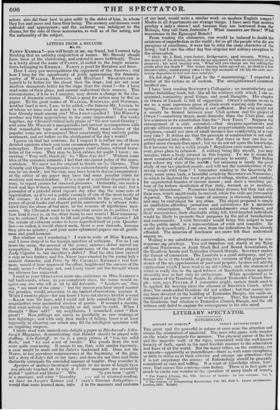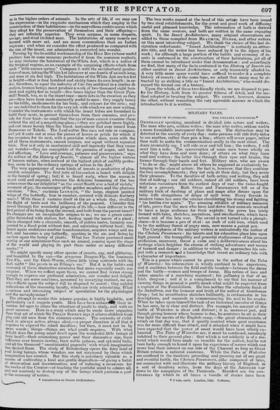-
LITERARY SPECTATOR.
ENTOMOLOGY.
HISTORY OF INSECTS, INSECT ARCHITECTURE.t
THE great and the powerful in nature at once seize the attention and obtain the admiration of mankind. The man who gazes with wonder on the whale disregards the minnow. The physical power of the lion and the majestic walk of the tiger, associated with the well-known ferocity of both, speak in the most forcible manner to the admiration and fears of all the world. But the insect tribes, on the contrary, are so minute—apparently so insignificant—there is, with some exceptions, so little to strike us in their exterior and engage our attention—that it is not surprising the science of Entomology should be generally considered as vain and trifling. It is want of knowledge alone, how- ever, that causes this contempi uous feeling. There is in fact quite as much to excite our wonder in the operation of many kinds of insects,
* The Family Library, No. VII. History of Insects. In two volumes. Vol. 1. London, 182). Murray.
t The Library of Entertaining Knowledge, Vol. III. Part I. Insect Architecture, London, 1820. as in the higher orders of animals. In the arts of life, if we may use the expression—in the exquisite mechanism which they employ in the construction of their habitations—in the marvellous contrivances which they adopt for the preservation of themselves and their offspring— they are infinitely superior. They even surpass, in some respects, savage, and rival civilized man. The habitations of many insects are formed with more • art, and are more commodious than an Indian wigwam; and when we consider the effect produced as compared with the size of the insect, our admiration is converted into wonder.
Passing by the beautiful workmanship of the Hive Bee (whose useful i
produce has n some measure protected it from the common neglect), we may instance the habitation of theWhite Ant, which is a native of
the tropical regions, as an example of the surprising effects which from such " little causes spring." Compare it with the architectural produc- lions of man, taking theWhiteAnt labourer at. one-fourth of an ineh long, and man at six feet high. The habitations of the White Ant are ten feet in height—that is four hundred and eighty times its own length : in or- der, therefore, to equal the industry of this tiny architect in a similar di-
rection, human beings must produce a work of twothousand eight hun-
dred and eighty feet in height—five times higher than the Great Pyra- mid! Small, too, as is the insect race—mere dots in the creation as they are—they have been made eminently useful to man : they supply honey for his table, medicaments for his body, and colours for the arts ; nay we are indebted to them for the very ink with which we are now writing. Consider the instruments with which the insect tribes are furnished to
build their nests, to protect themselves from their enemies, and pra- vide for their food—so small that the eye of man-cannot examine them
without the aid of a magnifying-glass ;—they are polished more highly,
and cut more keenly than the finest instrument that ever issued from Damascus or Toledo.. The Leaf-cutter Bee uses not rule or compass,
and yet it cuts out at once the pieces of leaves or petals for which it has occasion for its nest, with a precisibn which man; even with the aid of these instruments, cannot surpass, nor equal without repeated trials. Nor is it only in mechanical skill and ingenuity that they cause our wonder—they are susceptible of the passions of anger, and fear, and affection. " Love and courage, patience and perseverance," says the author of,the History of Insects, " almost all the higher virtues of human nature, when arrived at the highest pitch of earthly perfec- tion, seem to be the ordinary springs of action in the Ant." The very appearance of some kinds of insects is productive of plea- surable sensations. The first note of the cuckoo is heard with delight as the herald of spring; but] it is heard early, when the season is
as yet cold and ungemal, whereas the delicious humming of the bee comes over the ear-delightful " as the sweet South 'der a bed of violets,"
resonant of joy, the messenger of the golden meadows and the glorious sunshine. "See," exclaims LINNJEUS, "the large, elegant painted wings of the butterfly, four in number, covered with delicate feathery scales! With these it sustains itself in the air a whole clay, rivalling
the flight. of birds and the 'brilliancy of the peacock. Consider this insect through the wonderful progress of its life,—how different is the
first period of its being from the second, and both from the parent insect!
Its changes are an inexplicable enigma to us ; we see a green cater- pillar furnished with sixteen feet, feeding upon the leaves of a plant ;
this is changed into a chrysalis, smooth, of golden lustre, hanging sus- pended to a fixed point without feet, and subsisting without food ; this insect again undergoes another transformation, acquires wings and six feet, and becomes a gay butterfly, sporting in the air, and living by suction upon the honey of plants. What has Nature produced more worthy of our admiration than such an animal, coming upon the stage of the world and playing its part there under so many different masks ?"* We might specify many other species of insects, gay, and glittering, and beautiful to the eye—the gorgeous Dragon-Fly, the luminous Fire-Fly-, and the Glow-Worm, whose little lamp contrasts with the dark night " like jewels in an Ethiop's ear." But it is the habits and economy of these diminutive creatures that more especially excite our surprise. When we reflect upon them, we cannot find terms strong enough to express our profound admiration, our wonder and delight. That they are mere machines, governed by unvarying instinct, no one who reflects upon the subject will be disposed to assert : they exhibit indications of the reasoning faculty, which are truly astonishing. What a cmious and interesting subject of speculation for the physiologist and the metaphysician!
, The attempt to render this science popular, is highly la_udable, and I particularly as it regards youth. Men have been exhaus4lit their in- 1 vention for ages to allure the attention of youth to study, and with no great success. Here is a study which may be made more engaging than that art of which Sir PHILIP SIDNEY says it allures children from Iplay and old men from the chimney-corner. The curiosity of child- hood is always active, always alive,—a proper direction is all that it t.. requires to expand the infant faculties ; but then, it must not be by 1. mere words ; things—things are what youth requires. With what
t delight does the young mind dwell upon the wonderful little beings of i fairy land !—their astonishing power and their diminutive size, their
1 influence over human destiny, their noble palaces, and splendid halls,
; and all the thousand "unsubstantial pageants" wills which imagination has decked them. The study of Entomology opens the fairy land of i real living beings, whose wonders are not surpassed by those which imagination has created. But this study is peculiarly valuable as a
means of cultivating a kind and gentle disposition—of giving a habit - of observation and discrimination, and of inducing a reverence for
• the works of the Creator—of teaching the youthful mind to admire all, and not wantonly to destroy any of the beings which perform a part iii the economy of nature.
' * Introduction to Insect Architecture. The two works named at the head of this artiole have been issued by two rival establishments, for the great and good work of diffusing useful and pleasant knowledge. The information of both is derived from the same sources, and both are written in the same engaging spirit. In the Insect Architecture, many original observations are added to those compiled from REAUMUR, HUBER, and other writers on this most interesting subject. We think the choice of this last de- signation unfortunate. "Insect Architecture" is certainly an attrac- tive title, and the writer has been seduced by it to the injury of his work ; for although a' large portion of the habits and economy of in- sects is embraced in the construction of their habitations, yet all of them cannot be introduced under that denomination : and accordingly we find, that many of the facts contained in the History of Insects are either omitted in Insect Architecture, or only transiently alluded to. A very little more space would . have sufficed to render it a complete history of insects : at the same time, we admit that many may be at- tracted by so striking a title as "Insect Architecture," who would dis- regard the formal one of a history.
Upon the whole, of these two friendly rivals, we are disposed to pre- fer the History, both from its greater fulness of detail, and the me- thod adopted in treating the subject. We cannot, however, dismiss the other, without remarking the very agreeable manner in which the introduction to it is written.



















 Previous page
Previous page